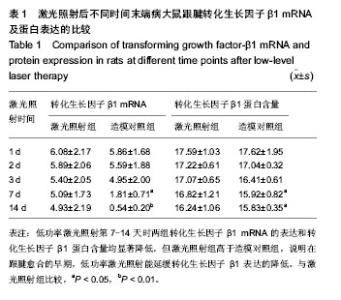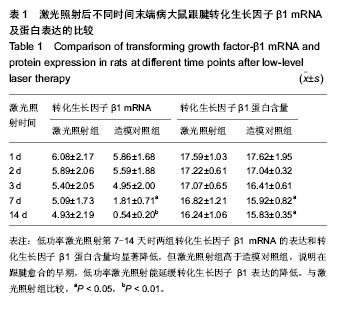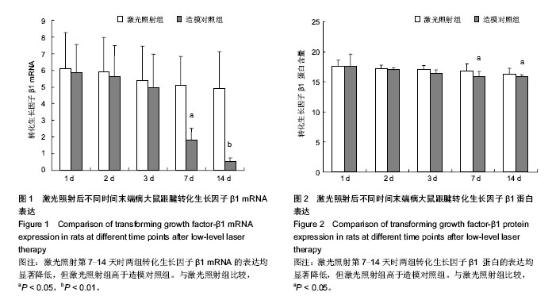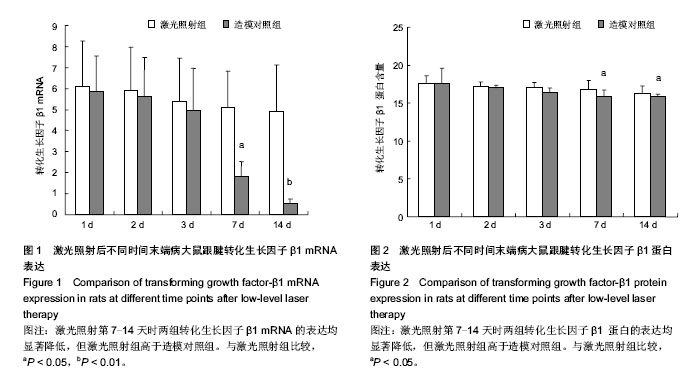Chinese Journal of Tissue Engineering Research ›› 2014, Vol. 18 ›› Issue (24): 3808-3813.doi: 10.3969/j.issn.2095-4344.2014.24.007
Previous Articles Next Articles
Transforming growth factor-beta 1 expression in early enthesiopathy of Achilles tendon in rats after low-level laser therapy
Shi Xiao-wei1, Long Li-juan1, Shen Yong-wei2, Wang Zhi-peng3
- 1School of Physical Education, Hainan Normal University, Haikou 571158, Hainan Province, China
2School of Physical Education, Soochow University, Suzhou 215021, Jiangsu Province, China
3Beijing Research Institute of Chemical Engineering and Metallurgy, CNNC, Beijing 101149, China
-
Revised:2014-03-15Online:2014-06-11Published:2014-06-11 -
Contact:Shen Yong-wei, M.D., Associate professor, School of Physical Education, Soochow University, Suzhou 215021, Jiangsu Province, China -
About author:Shi Xiao-wei, Master, Experimentalist, School of Physical Education, Hainan Normal University, Haikou 571158, Hainan Province, China -
Supported by:the Social Development Project of Jiangsu Province, No. BS2006020
CLC Number:
Cite this article
Shi Xiao-wei, Long Li-juan, Shen Yong-wei, Wang Zhi-peng. Transforming growth factor-beta 1 expression in early enthesiopathy of Achilles tendon in rats after low-level laser therapy[J]. Chinese Journal of Tissue Engineering Research, 2014, 18(24): 3808-3813.
share this article

2.1 实验动物数量分析 纳入Wistar大鼠96只,分为空白对照组8只、造模对照组48只激光照射组40只,所有大鼠均进入结果分析,实验过程中动物无脱失。 2.2 空白对照组和造模对照组大鼠跟腱转化生长因子β1的测试结果 mRNA表达:空白对照组转化生长因子β1 mRNA (2-△△CT)为1,而造模对照组为5.99±1.84,与空白对照组比较,造模对照组转化生长因子β1 mRNA的表达升高,差异有显著性意义(P < 0.05)。 蛋白含量:空白对照组转化生长因子β1蛋白含量为(15.76±0.83) mg/g,造模对照组为(17.85±1.97) mg/g,造模对照组的转化生长因子β1蛋白含量显著高于空白对照组 (P < 0.05)。 2.3 激光照射组和自然愈合组大鼠跟腱转化生长因子β1的测试结果 随着时间的增加,转化生长因子β1 mRNA的表达和转化生长因子β1蛋白表达均降低,激光照射组转化生长因子β1 mRNA的表达和转化生长因子β1蛋白表达下降幅度较慢,造模对照组转化生长因子β1 mRNA及蛋白表达下降迅速(表1)。 第1-3天时,激光照射组与造模对照组比较,大鼠跟腱转化生长因子β1 mRNA及蛋白表达差异无显著性意义 (P > 0.05),见图1,2。 第7天时,与激光照射组比较,造模对照组大鼠跟腱转化生长因子β1 mRNA及蛋白表达均显著降低,差异有显著性意义(P < 0.05),见图1,2。 第14天时,造模对照组大鼠跟腱转化生长因子β1 mRNA的表达低于激光照射组,差异有非常显著性意义 (P < 0.01),造模对照组大鼠跟腱转化生长因子β1蛋白表达也明显低于激光照射组,差异有显著性意义(P < 0.05),见图1,2。"

| [1] 于长隆.末端病[J].中国运动医学杂志,1984,3(3):180-186. [2] 史晓伟,岳秀飞.浅谈跟腱末端病[J].科技信息,2010,26(30):362. [3] Mulcahy D, McCormack D, McElwain J, et al. Low level laser therapy: a prospective double blind trial of its use in an orthopaedic population. Injury.1995;26(5): 315-317. [4] Bjordal JM, Lopes-Martins RA, Joensen J,et al.A systematic review with procedural assessments and meta-analysis of low level laser therapy in lateral elbow tendinopathy (tennis elbow). BMC Musculoskelet Disord. 2008;9:75. [5] Gur A, Sarac AJ, Cevik R,et al.Efficacy of 904 nm gallium arsenide low level laser therapy in the management of chronic myofascial pain in the neck: a double-blind and randomize-controlled trial.Lasers Surg Med. 2004;35(3): 229-235. [6] Gur A, Cosut A, Sarac AJ,et al.Efficacy of different therapy regimes of low-power laser in painful osteoarthritis of the knee: a double-blind and randomized-controlled trial.Lasers Surg Med. 2003;33(5):330-338. [7] 许松井.激光技术与医学应用[M].人民卫生出版社,1989: 308-313. [8] Morimoto Y, Saito A, Tokuhashi Y. Low level laser therapy for sports injuries. Laser Ther. 2013;22(1):17-20. [9] Zwerver J, Bredeweg SW, van den Akker-Scheek I.Prevalence of Jumper's knee among nonelite athletes from different sports: a cross-sectional survey.Am J Sports Med. 2011;39(9):1984-1988. [10] de Souza Merli LA, de Medeiros VP, Toma L, et al. The low level laser therapy effect on the remodeling of bone extracellular matrix. Photochem Photobiol. 2012;88(5): 1293-1301. [11] Lian OB, Engebretsen L, Bahr R.Prevalence of jumper's knee among elite athletes from different sports: a cross-sectional study.Am J Sports Med. 2005;33(4):561-567. [12] Fávaro-Pípi E, Ribeiro DA, Ribeiro JU, et al. Low-level laser therapy induces differential expression of osteogenic genes during bone repair in rats. Photomed Laser Surg. 2011;29(5): 311-317. [13] Fávaro-Pípi E, Bossini P, de Oliveira P. Low-intensity pulsed ultrasound produced an increase of osteogenic genes expression during the process of bone healing in rats. Ultrasound Med Biol. 2010;36(12):2057-2064. [14] Barbosa D, de Souza RA, Xavier M, et al. Effects of low-level laser therapy (LLLT) on bone repair in rats: optical densitometry analysis. Lasers Med Sci. 2013;28(2):651-656. [15] de Almeida P, Lopes-Martins RÁ, Tomazoni SS, et al. Low-level laser therapy improves skeletal muscle performance, decreases skeletal muscle damage and modulates mRNA expression of COX-1 and COX-2 in a dose-dependent manner. Photochem Photobiol. 2011; 87(5): 1159-1163. [16] Leal Junior EC, Lopes-Martins RA, de Almeida P, et al.Effect of low-level laser therapy (GaAs 904 nm) in skeletal muscle fatigue and biochemical markers of muscle damage in rats.Eur J Appl Physiol. 2010;108(6):1083-1088. [17] Rodrigues NC, Assis L, Fernandes KR, et al. Effects of 660 nm low-level laser therapy on muscle healing process after cryolesion. J Rehabil Res Dev. 2013;50(7):985-996. [18] Assis L, Moretti AI, Abrahão TB,et al.Low-level laser therapy (808 nm) contributes to muscle regeneration and prevents fibrosis in rat tibialis anterior muscle after cryolesion.Lasers Med Sci. 2013;28(3):947-955. [19] Patrocinio T, Sardim AC, Assis L, et al. Effect of low-level laser therapy (808 nm) in skeletal muscle after resistance exercise training in rats. Photomed Laser Surg. 2013;31(10): 492-498. [20] Fillipin LI, Mauriz JL, Vedovelli K, et al.Low-level laser therapy (LLLT) prevents oxidative stress and reduces fibrosis in rat traumatized Achilles tendon. Lasers Surg Med. 2005; 37(4): 293-300. [21] Rizzi CF, Mauriz JL, Freitas Corrêa DS, et al.Effects of low-level laser therapy (LLLT) on the nuclear factor (NF)-kappaB signaling pathway in traumatized muscle.Lasers Surg Med. 2006;38(7):704-713. [22] Joensen J, Gjerdet NR, Hummelsund S, et al. An experimental study of low-level laser therapy in rat Achilles tendon injury. Lasers Med Sci. 2012;27(1):103-111. [23] Laraia EM, Silva IS, Pereira DM,et al.Effect of low-level laser therapy (660 nm) on acute inflammation induced by tenotomy of Achilles tendon in rats.Photochem Photobiol. 2012;88(6): 1546-1550. [24] Oliveira FS, Pinfildi CE, Parizoto NA, et al. Effect of low level laser therapy (830 nm) with different therapy regimes on the process of tissue repair in partial lesion calcaneous tendon. Lasers Surg Med. 2009;41(4):271-276. [25] Kajagar BM, Godhi AS, Pandit A, et al. Efficacy of low level laser therapy on wound healing in patients with chronic diabetic foot ulcers-a randomised control trial. Indian J Surg. 2012;74(5):359-363. [26] Colombo F, Neto Ade A, Sousa AP, et al. Effect of Low-Level Laser Therapy (λ660 nm) on Angiogenesis in Wound Healing: A Immunohistochemical Study in a Rodent Model. Braz Dent J. 2013;24(4):308-312. [27] 沈勇伟,史晓伟.低功率激光修复末端病大鼠跟腱胶原[J]. 中国组织工程研究. 2012,16(28):5165-5169. [28] de Sousa AP, de Aguiar Valença Neto Ade A, Marchionni AM, et al.Effect of LED phototherapy (λ700 ± 20 nm) on TGF-β expression during wound healing: an immunohistochemical study in a rodent model.Photomed Laser Surg. 2011;29(9): 605-611. [29] 药立波,冯作化,周春燕.医学分子生物学[M].人民卫生出版社, 2004,8(2):122-125. [30] Massagué J. TGF-beta signal transduction. Annu Rev Biochem. 1998(67):753-791. [31] Ikedo H, Tamaki K, Ueda S, et al. Smad protein and TGF-beta signaling in vascular smooth muscle cells. Int J Mol Med. 2003; 11(5):645-650. [32] Robbins JR, Evanko SP, Vogel KG. Mechanical loading and TGF-beta regulate proteoglycan synthesis in tendon. Arch Biochem Biophys. 1997;342(2):203-211. [33] 夏长所,洪光祥,杨选影,等.转化生长因子-β1对肌腱腱鞘、腱外膜和腱内膜细胞增殖和胶原产生的影响[J].中华实验外科杂志, 2006;23(9):1109-1111. [34] Hou Y, Mao Z, Wei X, et al. The roles of TGF-β1 gene transfer on collagen formation during Achilles tendon healing. Biochem Biophys Res Commun. 2009;383(2):235-239. [35] Heinemeier K, Langberg H, Olesen JL, et al. Role of TGF-beta 1 in relation to exercise-induced type Ⅰ collagen synthesis in human tendinous tissue. J Appl Physiol. 2003; 95(6):2390-2397. [36] 王尉,何恢绪,彭心昭,等.转化生长因子-β1对肌腱细胞DNA及胶原合成的影响[J].中华创伤杂志,2001,17(10):618-619. [37] Tsubone T, Moran SL, Subramaniam M, et al. Effect of TGF-beta inducible early gene deficiency on flexor tendon healing. J Orthop Res. 2006;24(3):569-575. [38] 王尉,马晓东.基因治疗在组织修复的应用[J].医学综述, 2000, 6(10):433-435. [39] 熊雁,张正治.核心蛋白聚糖在肌腱愈合中的作用研究进展[J].国外医学•骨科学分册,2005,26(3):185-187. [40] 扈盛,欧高志,滕宇等.末端病造模方法的研究[J].武汉体育学院学报,2006, 40(4):79-81. [41] D’Souza D, Patel K. Involvement of long and short range signaling during early tendon development. Anat Embryol. 1999;200(4):367-375. [42] Cromack DT, Porras-Reyes B, Purdy JA, et al. Acceleration of tissue repair by transforming growth factor beta 1: identification of in vivo mechanism of action with radiotherapy-induced specific healing deficits. Surgery. 1993; 113(1):36-42. [43] Ngo M, Pham H, Longaker MT, et al. Differential expression of transforming growth factor-β receptors in a rabbit zone Ⅱ flexor tendon wound healing model. Plast Reconstr Surg. 2001;108(5):1260-1267. [44] 王尉,朴英杰,何恢绪.转化生长因子-β1对肌腱细胞增殖的调控作用[J].中华手外科杂志,2001,17(3):163-165. [45] Molloy T, Wang Y, Murrell G. The roles of growth factors in tendon and ligament healing. Sports Med. 2003;33(5): 381-394. |
| [1] | Sun Qi, Zhou Yanan, Dong Xin, Li Ning, Yan Jiazhen, Shi Haojiang, Xu Sheng, Zhang Biao. Metal-ceramic interface characteristics of Co-Cr alloy fabricated by selective laser melting [J]. Chinese Journal of Tissue Engineering Research, 2021, 25(4): 521-525. |
| [2] | Wang Hao, Chen Mingxue, Li Junkang, Luo Xujiang, Peng Liqing, Li Huo, Huang Bo, Tian Guangzhao, Liu Shuyun, Sui Xiang, Huang Jingxiang, Guo Quanyi, Lu Xiaobo. Decellularized porcine skin matrix for tissue-engineered meniscus scaffold [J]. Chinese Journal of Tissue Engineering Research, 2021, 25(22): 3473-3478. |
| [3] | Li Rong, Zuo Enjun. Gingival retraction: application profiles and hot spotlights [J]. Chinese Journal of Tissue Engineering Research, 2021, 25(2): 322-328. |
| [4] | Liu Yunyi, Wang Bo, Wang Lin. Effects of post-exercise gastrocnemius needling on Achilles tendon degeneration in obese rats [J]. Chinese Journal of Tissue Engineering Research, 2021, 25(14): 2211-2218. |
| [5] | Liu Zhigang, Guo Qinggong, Chen Jingtao. Effect of Capparis spinosa total alkaloid on proliferation and apoptosis of nucleus pulposus cells in an intervertebral disc degeneration rat model [J]. Chinese Journal of Tissue Engineering Research, 2021, 25(11): 1699-1704. |
| [6] | Luo Yaxin, Bi Haoran, Chen Xiaoxu, Yang Kun. Extracellular matrix and tissue engineering regeneration and repair [J]. Chinese Journal of Tissue Engineering Research, 2021, 25(11): 1785-1790. |
| [7] | Li Junqi, Tian Guangzhao, Chen Mingxue, Wang Hao, Liu Shuyun, Sui Xiang, Huang Jingxiang, Li Ming, Guo Quanyi. Regulatory effect of acellular cartilage extracellular matrix on phenotype of mouse macrophage line [J]. Chinese Journal of Tissue Engineering Research, 2021, 25(10): 1512-1516. |
| [8] | Guo Haoyu, Li Weiquan, Liu Kaiyuan, Xiao Ruifen, Sun Denglong, Xi Jiaoya. Recent research progress in construction of biomimetic engineered cardiac tissue based on extracellular matrix [J]. Chinese Journal of Tissue Engineering Research, 2021, 25(10): 1577-1584. |
| [9] | Wu Ming, Zhang Yan. Related factors regulating osteogenic differentiation of bone marrow mesenchymal stem cells through Wnt/β-catenin signaling pathway [J]. Chinese Journal of Tissue Engineering Research, 2021, 25(1): 116-122. |
| [10] | Liu Chunyu, Han Xiaoyan, Wang Lin. Basic science related to tendinopathy: microbiomechanics and stress shielding [J]. Chinese Journal of Tissue Engineering Research, 2020, 24(5): 766-772. |
| [11] | Qiu Guorong, He Benxiang, Wang Chun. Biological mechanism of platelet-rich plasma for tendinopathy repair: a visual study based on scientific knowledge map [J]. Chinese Journal of Tissue Engineering Research, 2020, 24(5): 787-795. |
| [12] | Yao Lu, Hu Peixin, Liu Wu, Lü Qitao, Nie Zilin, He Zhengdi. Application and prospects of 3D printing technology in dental manufacturing [J]. Chinese Journal of Tissue Engineering Research, 2020, 24(4): 637-642. |
| [13] | Wang Zhihao, Wu Cong, Wu Sihua, Shi Hongcan. Application and characteristics of decellularization technology in tissue engineered trachea [J]. Chinese Journal of Tissue Engineering Research, 2020, 24(35): 5695-5700. |
| [14] | Yang Wenxiao, Yang Ning, Liu Yao. Immunomodulation of extracellular matrix and its role in tissue regeneration [J]. Chinese Journal of Tissue Engineering Research, 2020, 24(35): 5701-5707. |
| [15] | He Jing, Ao Qiang. Research hotspots in tissue decellularization method for manufacturing extracellular matrices [J]. Chinese Journal of Tissue Engineering Research, 2020, 24(34): 5413-5420. |
| Viewed | ||||||
|
Full text |
|
|||||
|
Abstract |
|
|||||

